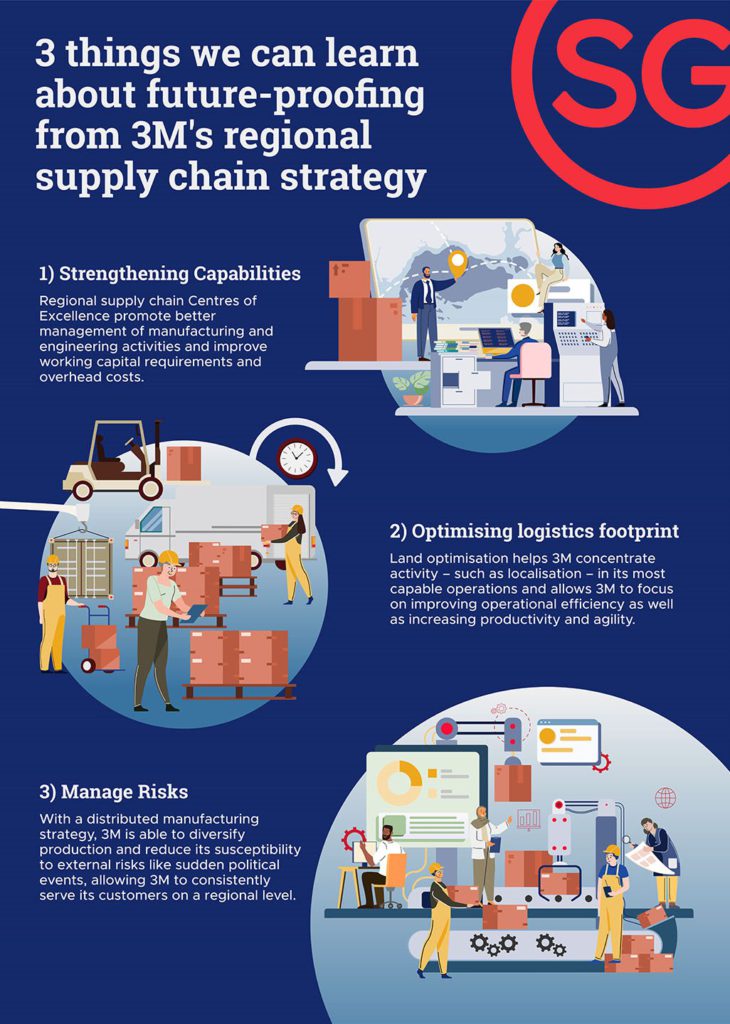Since the pandemic, we’ve seen how susceptible supply chains can be to external disturbances. Global disruptions exposed the vulnerabilities of complex supply chains and revealed how abruptly production and manufacturing processes could ground to a halt.
However, with challenges also come opportunities — discovering potential vulnerabilities and pain points has led companies to rethink the way that they manage and run their businesses.
In particular, against the backdrop of a world confronted by a possible ‘polycrisis’, a term used to describe a series of volatile and interconnected global crises, building and increasing supply chain resilience has become a top priority for business leaders and decision makers.
To boost supply chain resilience in the face of evolving pressures and constraints, Multi-National Enterprises (MNEs) must move to reorganise and re-examine their existing supply chain networks. This could entail relocating their manufacturing footprint and diversifying their sources of supply.
Reshoring, which entails shifting manufacturing operations to the same country in which the company is operating in, may not be the most effective strategy to manage risks.
Rather, regionalization – a process of splitting manufacturing footprint across more localised economies could enhance supply chain resiliency and allow teams to respond to disruptions quickly. It also further empowers companies to tailor the production and distribution of goods to match the preferences of consumers in the region in a more time- and cost-efficient way.
3M’s backstory — from Minnesota to Singapore
In 1966, 3M, the multi-national conglomerate well-known and loved for their emblematic Post-it® Notes, Scotch-Brite™ scrub sponges, Nexcare™ band-aids, and all-purpose Command™ hooks, set down its first roots in Singapore, a newly-independent island nation at the time.
First established in Minnesota, United States in 1902, 3M was already known as an ‘innovation machine’ for constantly designing and churning out exciting new products across industries. But even then, their foray into the ASEAN region had humble beginnings, with just eight employees in a single office space.
Over the years, 3M has grown immensely alongside Singapore, weathering storms like the Asian Financial Crisis in 1997, the Global Financial Crisis in 2008, and the global Coronavirus pandemic in 2020. 3M has also gradually expanded its regional team to more than 1,800 Singapore-based employees across multiple facilities in the country.
Regionalization as a way forward in a ‘polycrisis’ world
With an effective regionalization strategy which takes into account the consolidation and management of supply chain risks, 3M is able to remain resilient and sustainable in its ASEAN (the Association of Southeast Asian Nations) expansion and operations.
Recognising the potential of this region, 3M seized the opportunity to kickstart their plans to regionalize and transform their supply chain by expanding to Singapore in 1966, and over time, has set up multiple facilities for manufacturing, research and development, supply chain, and business operations.
By implementing both short-term and long-term strategies to tackle supply chain disruptions and build resiliency, 3M has been able to recover from setbacks — pandemic-induced or otherwise — and grow from strength-to-strength.
We share some key insights below, and delve more deeply in this case study:

3M’s regionalization strategy helped it to ride the waves of COVID, allowing for continued global expansion even during global supply chain challenges. Since establishing its first presence here over the past 50 years, 3M has benefitted from Singapore’s stable business environment and robust IP regulatory framework. 3M has also strengthened its position as a global talent node in the region to realise its goal of providing “region for region” products.
Supported by the trust and stability offered by Singapore as a host for its regional headquarters, 3M was able to create more resilient and sustainable supply chains by embracing new technologies in the digitalisationand transformation of its business.
The heavy investment in digitalization and innovation also enabled 3M to establish a more transparent supply chain that can better anticipate potential bottlenecks by building closer connections with suppliers. The enhanced visibility and better decision-making capabilities provided 3M with much-needed agility in times of crisis.
The use of technology has also helped to improve sustainability and allowed 3M to gain a competitive advantage in this space. For example, by working with paper suppliers to trace the trees from which products originated, 3M was able to implement a digital partner-to-partner information flow to enforce sustainable sourcing. Partnerships with not-for-profit organisations and cloud-based applications are other examples of 3M implementing more sustainable supply chain practices and championing responsible sourcing and traceability.
The road ahead
With an uncertain and volatile business landscape looking to be a mainstay in the near future, a company’s ability to adapt to changes determines its ability to weather any economic or geopolitical changes.
3M’s forward-thinking strategies and continued spirit of innovation enabled the company to leverage Singapore’s advantages, including a favourable geographic location in the Asia Pacific region, stable business environment, and commitment to technology, to overcome disruptions and remain future-ready.
Get detailed insights into 3M’s forward-thinking and future-ready strategies which enabled the company to leverage Singapore’s advantages for continued growth in the Asia Pacific region and beyond. Download the case study here.
This article was first published by the Singapore Economic Development Board (EDB). The Singapore Economic Development Board (EDB), a government agency under the Ministry of Trade and Industry, is responsible for strategies that enhance Singapore’s position as a global centre for business, innovation, and talent. Have the latest insights, stories and analyses on how companies are growing in Asia delivered to your inbox here.

